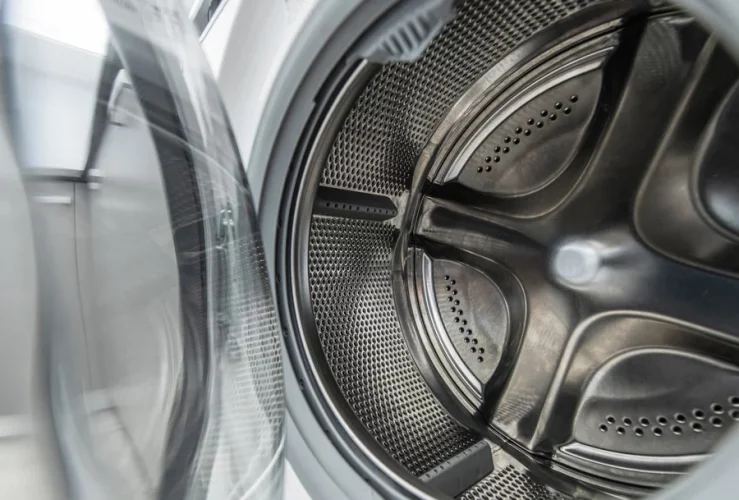Water leaks in Samsung washing machines can lead to poor cleaning performance, potential water damage, and appliance failure if not addressed promptly. Error codes LE, LC, E9, and 11E signal potential leaks or drainage system malfunctions.
Understanding and troubleshooting these issues is crucial for maintaining the efficiency and longevity of your washer. This guide provides step-by-step instructions for diagnosing and resolving water leak-related error codes. If DIY troubleshooting does not fix the issue, booking a professional repair service through our website ensures a reliable solution.
Understanding Error Codes LE, LC, E9, and 11E
Below is an overview of common Samsung washer water leak error codes:
Error Code | Meaning | Possible Causes |
LE | Water leak detected | Loose hose connections, internal leaks, over-sudsing |
LC | Updated version of LE (new models) | Similar to LE; newer model designation |
E9 | Drainage system issue | Incorrect hose placement, leaking components |
11E | Water detection error | Sensor malfunction, leaks, excess water levels |
If your Samsung washer displays any of these codes, follow the troubleshooting steps below.

Detailed Error Code Analysis
Common causes of water leak Errors
- Loose or damaged hose connections – Water may leak if hoses are not secured properly.
- Faulty water inlet valve – A malfunctioning valve may lead to uncontrolled water flow.
- Over-sudsing from excess detergent – Too much detergent can trigger leaks and drainage issues.
- Clogged or misaligned drain hose – Blockages can cause water to back up and leak.
- Internal washer leaks – A damaged tub or internal component may be leaking.
Step-by-step troubleshooting guide
How to address Error Code LE in Samsung Washers
Step 1: Inspect for leaks around the washer
✔ Check underneath and around the washer for water puddles.
✔ Look for damp hoses, loose connections, or cracks in hoses.
✔ If water is present, turn off the washer and unplug it immediately.
Step 2: Check and secure hose connections
✔ Ensure the inlet hoses are tightly connected to both the washer and the water supply.
✔ Inspect for leaks at hose joints—tighten or replace damaged hoses.
✔ Verify that the drain hose is properly secured and not bent or misaligned.
Step 3: Examine the washer’s drainage system
✔ Inspect the drain pump filter for blockages or debris.
✔ Check that the drain hose is positioned correctly (not too high or too low).
✔ Run a rinse and spin cycle to test for leaks after adjustments.
📞 If the issue persists, book a professional repair service through our website!
Diagnosing and Resolving Error Code LC
Since LC is an updated version of LE, follow the same troubleshooting steps above.
Additional steps for LC:
✔ Reduce detergent usage—excessive suds can cause leakage.
✔ Check for signs of water overflow—if the washer is filling too much, the pressure sensor may be faulty.
✔ Ensure the washer is level—uneven placement can cause leaks from improper drainage.
📅 Need expert help? Schedule a repair appointment through our website today!
Troubleshooting Error Codes E9 and 11E
These errors indicate potential leaks or water detection issues.
✔ Inspect the water level sensor—if faulty, it may misread water levels and cause errors.
✔ Check the drain hose positioning—ensure it is not submerged in standing water.
✔ Look for internal leaks—remove the washer’s back panel to inspect for dripping water.
✔ Test the washer without detergent—if suds disappear, excess detergent was likely the issue.
📞 Persistent leaks? Contact a technician for a full inspection.
Preventive maintenance tips
To prevent future water leaks and error codes, follow these best practices:
✔ Check hose connections every three months—tighten any loose fittings.
✔ Use HE (high-efficiency) detergent to prevent excessive suds and overflow.
✔ Avoid overloading the washer—too much laundry can lead to drainage issues.
✔ Keep the drain pump filter clean—inspect and remove debris regularly.
✔ Ensure the washer is properly installed—level the machine to prevent shifting and misalignment.
📅 Schedule a maintenance service with our professionals today!
When to call a professional?
If LE, LC, E9, or 11E errors persist despite troubleshooting, seek professional help. Contact a technician if:
✔ Water leakage continues after securing hoses and checking connections.
✔ The washer overfills or drains improperly, indicating a sensor or pump issue.
✔ The error code reappears after resetting the washer.
✔ There are visible cracks, leaks, or unexplained water accumulation inside the machine.
📞 Book a Samsung washer repair today for fast, guaranteed service!
Conclusion
Samsung washer water leak error codes (LE, LC, E9, and 11E) indicate potential leaks, hose connection issues, or drainage failures. Prompt troubleshooting prevents further damage and keeps your washer in top condition.
By following this guide, you can diagnose and fix the problem yourself. If the issue persists, professional repair services are just a click away!
📞 Call Now for Expert Samsung Washer Repair!




